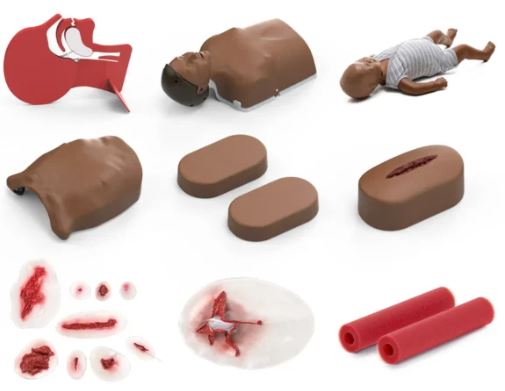EMERGENCY CARE LEARNING LAB
Valid Article
EMERGENCY CARE LEARNING LAB
Definition
The Emergency Care Learning Lab is designed to support training in basic emergency care for adults and children, including WHO's Basic Emergency Care program, the Community First Aid Responder program, and the Basic Critical Care program.
The kit is also ideal for CPR training, as it includes adult and infant CPR manikins, along with a free app that provides real-time feedback, interactive challenges, and tips to enhance CPR performance.
Specifications
Technical specifications
- Training tools:
- Head Section Model
- Little Anne for Emergency Care
- Needle Decompression Trainer
- 2 x IV Access Pad
- Deep Wound
- 2 x Foam Rolls
- 10 wounds
- Backpack
- Complementary app for feedback on ventilation and CPR performance
- Little Baby QCPR and Little Baby carry bag (only included in the full version)
- Extra items:
- USB stick with instructional videos
- Tape roll for needle decompression trainer
- Blood powder
- Lubricant for NPA insertion
- Extra silicone tubes for IV Access Pad
- 4 x AA Batteries for CPR manikins
Operating temperature: +15º to +40ºC
Dimensions
- Size (L x W x H) [cm]: 68×43×39 cm (backpack)
- Weight (kg): 8.5 kg
To be Ordered Separately
Optional, need to be ordered separately:
- Silicone Resuscitator – Adult
- Silicone Resuscitator – Pediatric
Instructions for use
- Head Section Model: Anatomical model for visualization of
- Head-tilt and chin lift
- Jaw thrust
- Placement of OPA and NPA tubes
- Little Anne for Emergency Care: Adult manikin for:
- Head-tilt and chin lift
- Jaw thrust
- Bag-valve-mask ventilation
- Insertion of nasopharyngeal airway (NPA)
- Insertion of oropharyngeal airway (OPA)
- Airway suctioning
- Supplemental oxygen
- CPR training
- Little Baby QCPR: Baby manikin for:
- Head-tilt and chin lift
- Jaw thrust
- Management of choking
- Bag-valve-mask ventilation
- Airway suctioning
- Supplemental oxygen
- CPR training
- Needle Decompression Trainer
- Chest model for emergency needle decompression.
- Can also be used as anatomical model for management of sucking chest wound.
- Deep wound
- For practicing deep wound packing.
- IV pads
- For practicing insertion of IV cannula.
- Foam rolls
- For wound demonstration and how to apply tourniquet.
- Wounds: For visual demonstration or simulation training in how to manage wounds. Wounds included:
- Burns (partial thickness)
- Small and large lacerations
- Gunshot wounds
- Deep tissue wound
- Snake bite
- Round wound (bleeding vessel)
- Small wound (bleeding vessel)
- Open fracture.
Maintenance
See user guide
Cleaning and storage after use
- Clean components after heavy use or liquid exposure.
- Wipe components with a damp cloth and mild soap to remove stains and glue residue
- The nasal airways typically do not require cleaning of the lubrication. However, if you notice increased resistance during insertion of the NPA, gently rinse the nasal airway with clean water.
Store as directed in the packing instructions inside the backpack. Avoid prolonged exposure to direct sunlight and temperatures above 35°C.
Storage
- Temperature; 20°C
- Relative humidity: 5-95%
MSF requirements
The use of the training kit is educational for teaching emergency care trainings, both BEC (Basic Emergency Care, and BASIC Low Resource) both trainings offered intersectionally by MSF L&D.





![[EANERESU1NU] RESUSCITATOR (Laerdal Upright), neonate + MASK n°0 and n°1](/web/image/product.template/573289/image_256/%5BEANERESU1NU%5D%20RESUSCITATOR%20%28Laerdal%20Upright%29%2C%20neonate%20%2B%20MASK%20n%C2%B00%20and%20n%C2%B01?unique=da5f4da)
![[EANERESU2AC] RESUSCITATOR MANUAL (Ambu), ad./child + masks RH5 / RH2](/web/image/product.template/569378/image_256/%5BEANERESU2AC%5D%20RESUSCITATOR%20MANUAL%20%28Ambu%29%2C%20ad.-child%20%2B%20masks%20RH5%20-%20RH2?unique=281bd43)
![[EANERESU2CN] RESUSCITATOR MANUAL (Ambu), child + masks RH2/S1](/web/image/product.template/569376/image_256/%5BEANERESU2CN%5D%20RESUSCITATOR%20MANUAL%20%28Ambu%29%2C%20child%20%2B%20masks%20RH2-S1?unique=370142d)